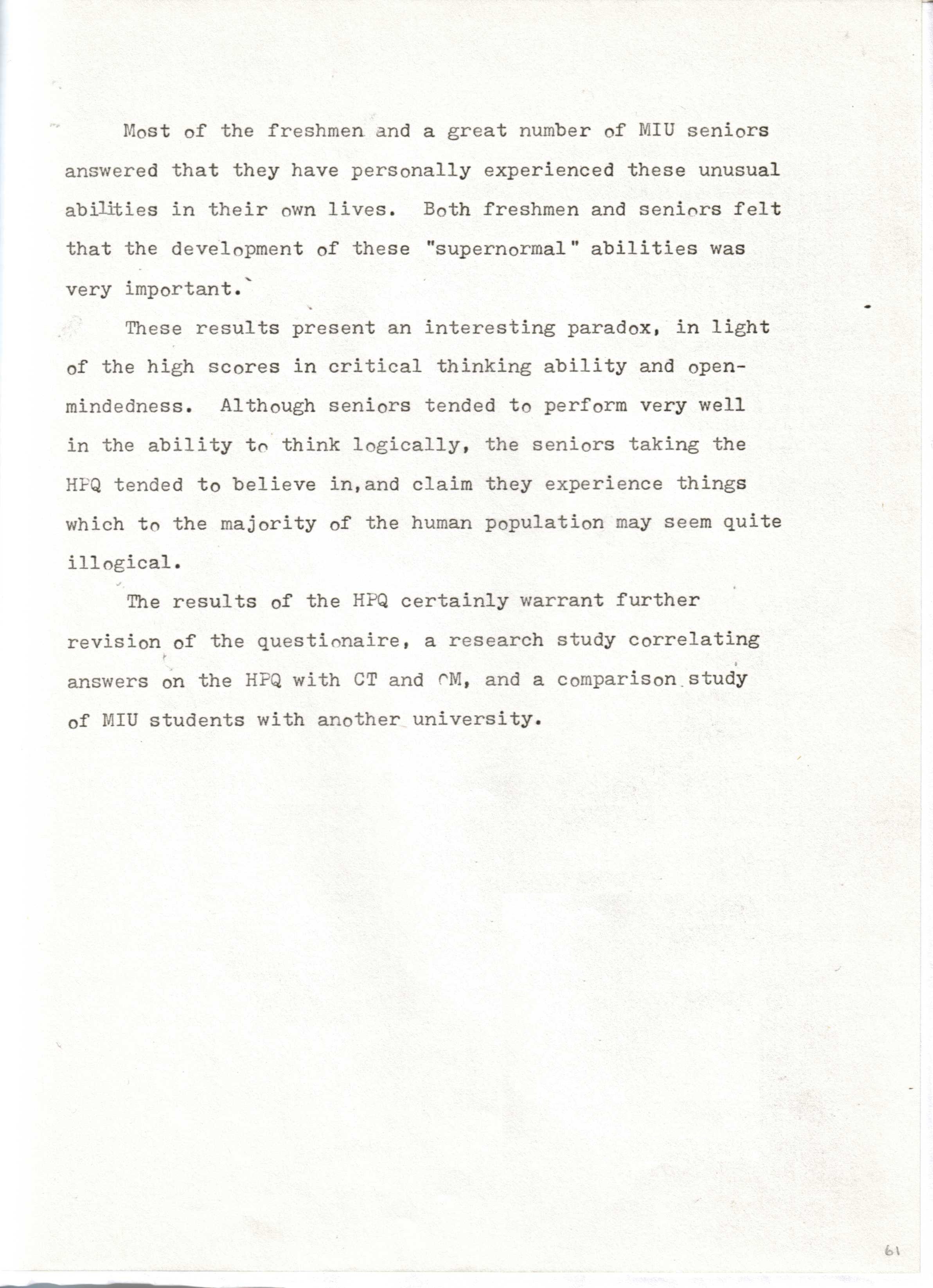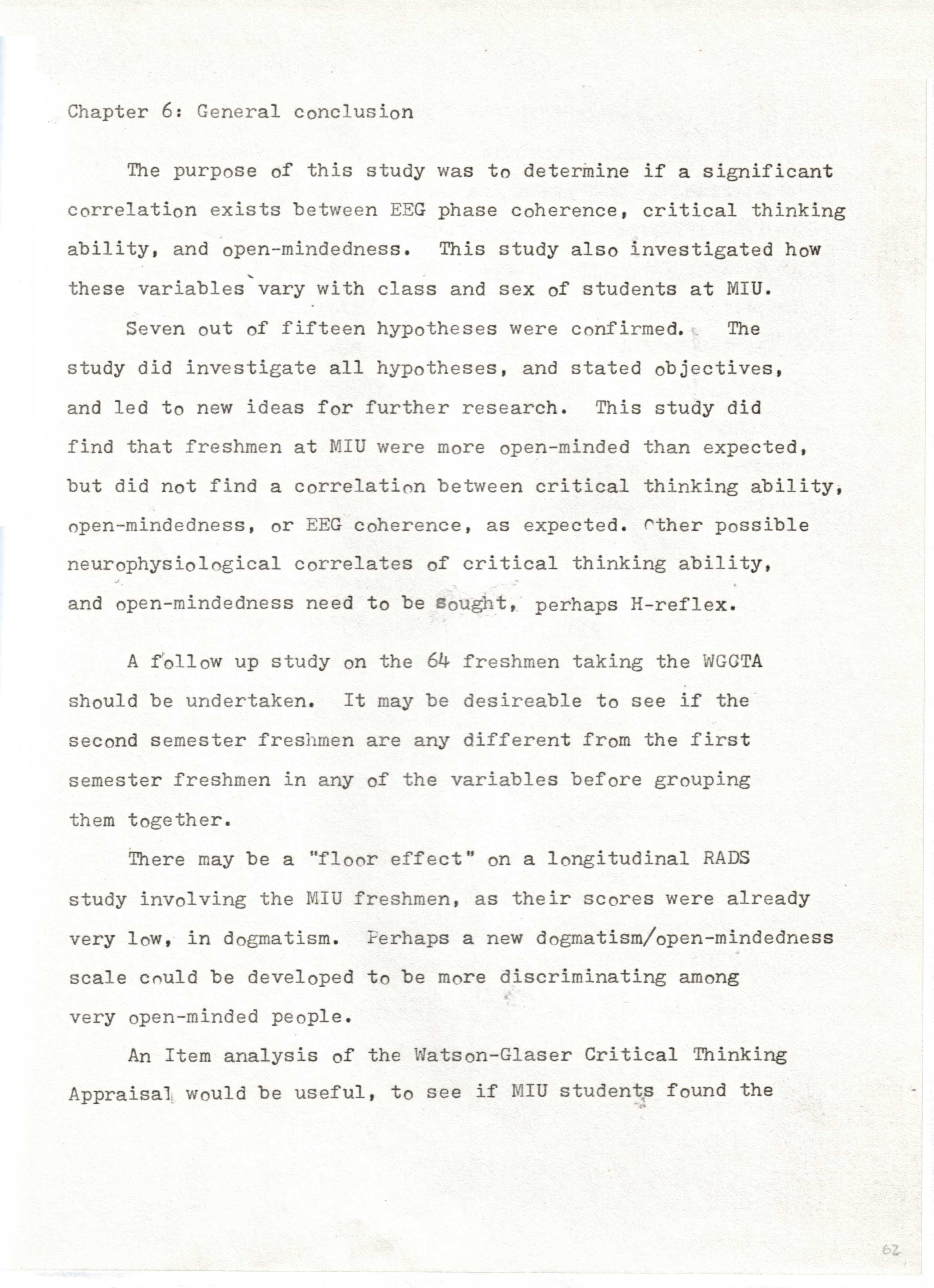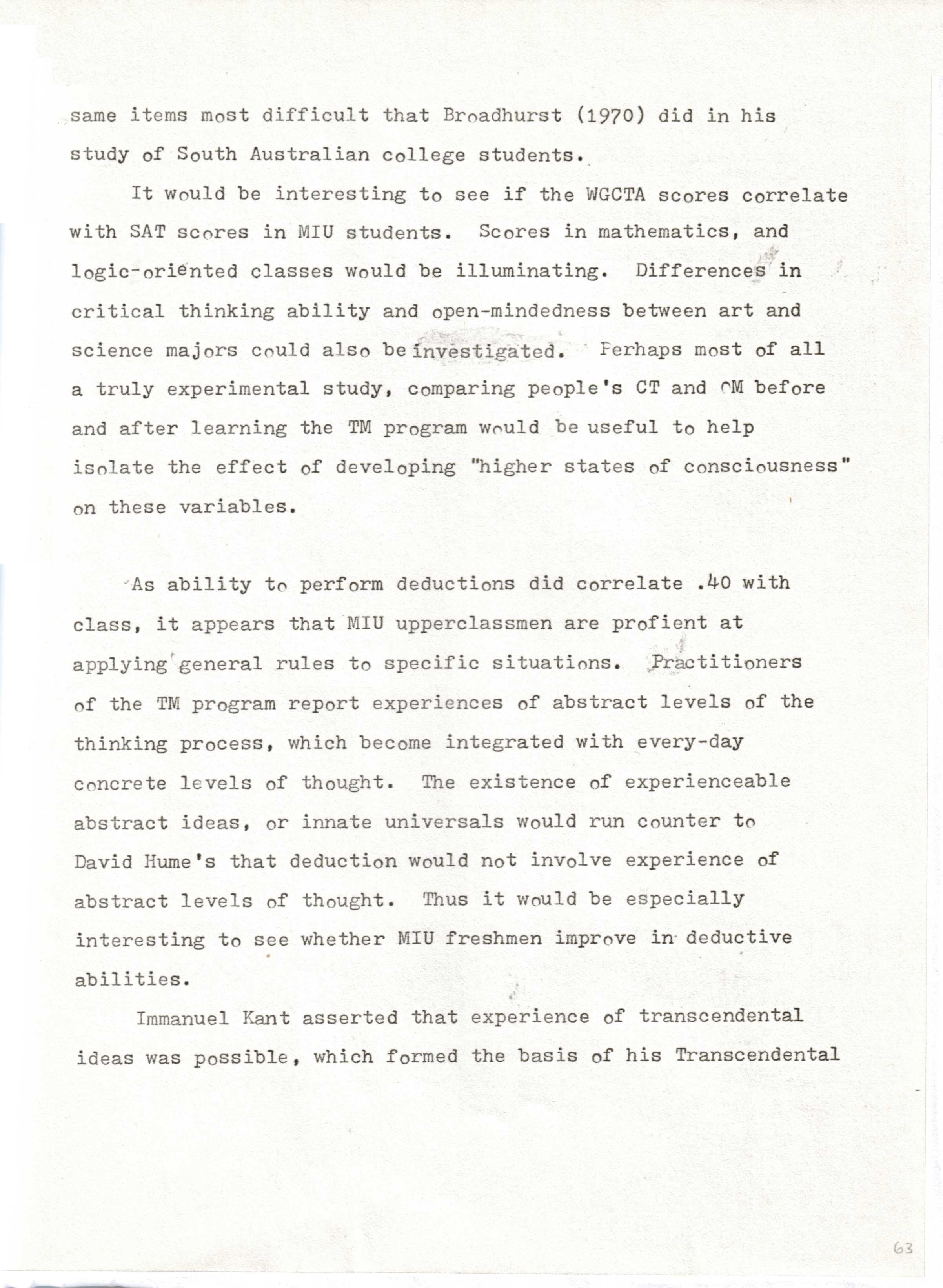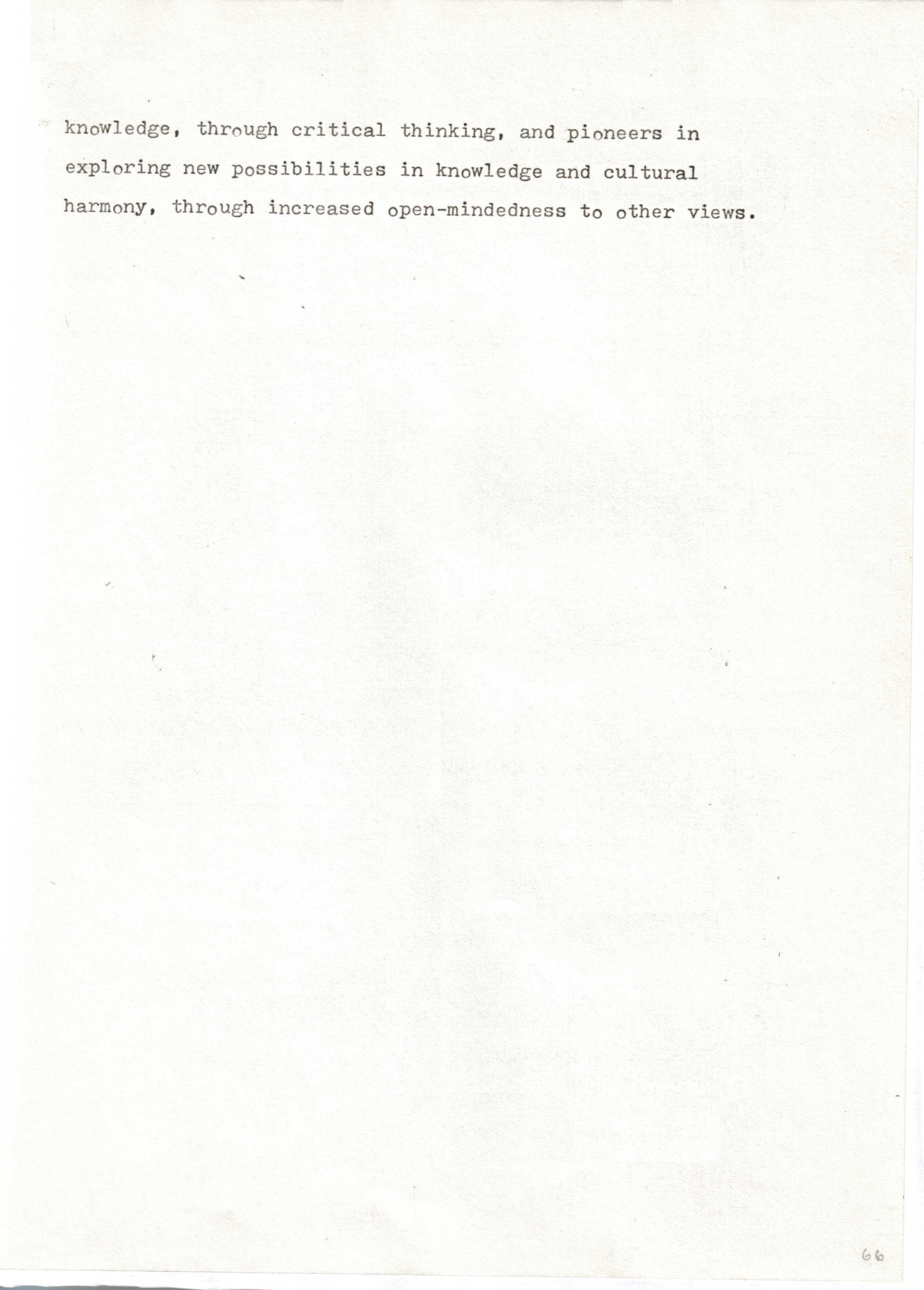
ctomeegmiu61.jpg
|
Most of the freshmen and a great number of
MIU seniors
answered that they have personally
experienced these unusual
abilities in their own lives. Both freshmen
and seniors felt
that the development of these "supernormal"
abilities was very important.
These results present an interesting
paradox. in light
of the high scores in critical thinking
ability and open-mindedness. Although seniors tended to
perform very well
in the ability to think logically, the
seniors taking the
HPQ tended to believe in, and claim they
experience things
which to the majority of the human
population may seem quite
illogical.
The results of the HPQ certainly warrant further
revision of the questionnaire, a research
study correlating
answers on the HPQ with CT and OM, and a
comparison study
of MIU students with another university. |

ctomeegmiu62.jpg
|
Chapter 6: General conclusion The purpose of this study was to determine
if a significant
correlation exists between EEG phase
coherence, critical thinking
ability, and open-mindedness. This study
also investigated how
these variables vary with class and sex of
students at MIU.
Seven out of fifteen hypotheses were
confirmed. The
study did investigate all hypotheses, and
stated objectives,
and led to new ideas for further research.
This study did
find that freshmen at MIU were more
open-minded than expected,
but did not find a correlation between
critical thinking ability,
open-mindedness, or EEG coherence, as
expected. Other possible
neurophysiological correlates of critical
thinking ability,
and open-mindedness need to be sought,
perhaps H-reflex.
A follow up study on the 64 freshmen taking
the WGCTA
should be undertaken. It may be desirable
to see if the
second semester freshmen are any different
from the first
semester freshmen in any of the variables
before grouping
them together.
There may be a "floor effect" on a
longitudinal RADS
study involving the MIU freshmen, as their
scores were already
very low, in dogmatism (high in open-mindedness). Perhaps a new
dogmatism/open-mindedness
scale could be developed to be more
discriminating among
very open-minded people.
An Item analysis of the Watson-Glaser
Critical Thinking
Appraisal would be useful, to see if MIU
students found the |

ctomeegmiu63.jpg
|
same items most difficult that Broadhurst
(1970) did in his
study of South Australian college students. It would be interesting to see if the WGCTA
scores correlate
with SAT scores in MIU students. Scores in
mathematics, and
logic-oriented classes would be
illuminating. Differences in
critical thinking ability and
open-mindedness between art and
science majors could also be investigated.
Perhaps most of all
a truly experimental study, comparing
peop1e's CT and OM before
and after learning the TM program would be
useful to help
isolate the effect of developing "higher
states of consciousness”
on these variables.
As ability to perform deductions did
correlate .40 with
class, it appears that MIU upperclassmen
are proficient at
applying general rules to specific
situations. Practitioners
of the TM program report experiences of
abstract levels of the
thinking process, which become integrated
with every-day
concrete levels of thought. The existence
of experienceable
abstract ideas, or innate universals would
run counter to
David Hume's that deduction would not
involve experience of
abstract levels of thought. Thus it would
be especially
interesting to see whether MIU freshmen
improve in deductive
abilities.
Immanuel Kant asserted that experience of
transcendental
ideas was possible, which formed the basis
of his Transcendental |

ctomeegmiu64.jpg
|
Logic. Domash (1977} describes the
experience of transcendental
consciousness during the TM program as
contacting a field of
pure orderliness, or zero entropy. The TM
program apparently
makes use of the Third Law of
Thermodynamics in bringing the
activity of the mind to a more settled, and
orderly state.
This most orderly state of the mind seems
to be an experience
of contacting a transcendental field of
pure logic.
The Science gf Creative Intelligence (SCI)
describes
this state as a field of pure knowledge,
the eternal Veda.
Vedic Science is the science of the Veda,
and is the fulfillment
of SCI. It is predicted that through the
practice of the
experiential aspect of Vedic Science, the
TM program, knowledge
of the entire field of knowledge, Veda,
grows in one‘s awareness.
Vedic Science outlines the general
structure of knowledge
itself. One branch of the Veda, one of the
"Upangas“, is
Nyaya. Nyaya is "the science of reasoning“
which "presents
sixteen points by which to test the
procedure of gaining
knowledge" (Maharishi, 1967, p.4?3).
Apparently, the MIU
seniors especially have the Nyaya aspect of
the Veda well
structured in their awareness.
The results of this research paper on
open-mindedness
provide empirical insight into the nature
and meaning of
dogmatism. Cornman and Lehrer write (1972)
that "If religious
revelation was the dogmatism of the past,
scientific empiricism
is the dogma of today" and that "the plain
man, we have suggested,
|

ctomeegmiu65.jpg
|
is a dogmatist. He dogmatically assumes his
perceptual
beliefs, many of them, at any rate,
constitute knowledge" (p.61).
It is interesting to note that the motto of
MIU is that
"Knowledge is structured in consciousness“,
and that MIU's
curriculum adds to objective, perceptual
knowledge, the
value of subjective, intuitive knowledge.
The MIU students
would, through the development of their
intuitive faculties
which the TM program presumable cultures,
be able to integrate
the subjective and objective means to gain
knowledge. This
ability to see knowledge from both
subjective and objective
perspectives may be an explanatory factor
in their low scores
in dogmatism, and high scores for open-mindedness..
The research results in this paper are not
opposed to
the possibility that the Science of
Creative Intelligence,
and its practical aspect, the
Transcendental Meditation and TM-Sidhi program, develop critical thinking
ability and
open-mindedness. This may be better
determined through a
longitudinal study on students practicing
the TM program.
The theoretical foundation of SCI
concerning the
development of discriminating intellect and
expanded awareness,
indicates that the TM program has the
potential to develop
critical consciousness, and open-awareness.
If this proves
possible, and if the practice of the TM
program becomes
implemented in more educational curricula,
we may be able
to look forward to students who are greater
purifiers of
|

ctomeegmiu66.jpg
|
knowledge, through critical thinking, and
pioneers in
exploring new possibilities in knowledge
and cultural
harmony, through increased open-mindedness
to other views.
|